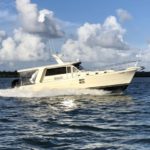Cummins Marine Diesel Repower Specialists › Forums › Cummins Marine Engines › QSB 6.7 Heat exchanger corrosion
- This topic has 12 replies, 5 voices, and was last updated 4 years ago by
 Rob Schepis.
Rob Schepis.
-
CreatorTopic
-
April 19, 2019 at 5:19 am #67397
At 2000 hour service heat exchanger badly corroded. Radiator shop supporting large diesel shop could not get core out. Have owned boat for 2 years. Zincs in heat exchanger have shown little wear during that time. Corrosion and little zinc wear seem inconsistent. Thanks to previous advice from Seaboard, I learned the QSB 6.7 after cooler had plastic caps. (Discovered when unable to remove zincs.) When changing out plastic after cooler caps and seeing zincs for first time-discovered little wear on after cooler zincs. Probably not working. Is this the same for heat exchanger?
Are heat exchanger zincs functioning if in plastic caps. Are there non-plastic replacements? As it stands now we are looking at a new heat exchanger (at 2000 hrs?!) from Cummins. Very spendy and unwarranted if this is a design issue. Would welcome any advice?
-
CreatorTopic
-
AuthorReplies
-
May 24, 2019 at 5:30 am #70009

Rob SchepisForum ModeratorVessel Name: Tenacious
Engines: 6BTA 5.9 330's - "Seaboard Style"
Location: Long Island, NY
Country: USA
That unusual wear in the pictured zinc could be the result of erosion due to it’s location in the water flow and small pcs of debris (old zinc pcs, sand, etc) that have settled down and accumulated around it that is continually blasting the zinc with the water flow. Next time you remove it, stick your pinky in the hole and feel around it and see if you feel loose gritty material surrounding the zinc port.
1 user thanked author for this post.
May 23, 2019 at 10:31 pm #70004
Trevor D’AltonParticipantVessel Name: KODIAK
Engines: Cummins QSB 6.7 380 hp X 2.
Location: Sydney
Country: Australia
QSB 6.7 variable and quick anode erosion.
I am new to the forum so I am not sure if this should be a new topic.
My engines each have 5 anodes of different sizes. Two on the after cooler (metal end caps), one on the gear cooler and two on the heat exchanger. The lower anode on the after cooler wears quickly but in an unusual pattern. The photo shows the wear after 3 months. The anode in the gear cooler is totally consumed in the same 3 months and needs to be replaced. Both these anode are vertically oriented which may or may not be significant. The other 3 anodes on each engine show very little wear after twelve months but show some calcium deposits. All anodes are fitted using Rectorseal thread sealant as specified in the maintenance manual.
The engines are 14 months old and have 120 hours on them and this has been the pattern of anode erosion since the beginning. The boat is used in sea water.
Can anyone shed any light on why this is happening?
April 27, 2019 at 5:41 am #68442
Tony AthensModeratorVessel Name: Local Banks
Engines: QSB 6.7 550 HP
Location: Oxnard, CA
Country: USA
QSB 6.7 HX Assembly
Scott
Look at the picture from QSOL.. I have been looking at this for years and have asked more than once about it with “people supposedly in the know”.. Only answer has been “head scratching” at this point.
The cost for a complete unit is not crazy, (about $2500), and there is a chance that if the components could be bought separately, each could be as much or more than the assembled unit–Now that would be crazy. but very possible. See it before.
Tony
April 27, 2019 at 12:42 am #68438Rob, Good point: if continuity is lost, replace the caps. It would be nice if metallic caps came onto the market. I will be exploring the options for setting up system for regular fresh water flush. Really appreciate your timely replies. Scott
April 27, 2019 at 12:38 am #68437Tony, Thanks for reply. In regards to the 6.7 HX, Cummins does show the HX core (part # 5273349) and housing (5289419) on their QuickServe online parts catalog as separate items. Do they seal them or otherwise make the core not removable at factory assembly? I thought I understood that the 5.9 HX was a single unit. I hope there will be enough 6.7s in the market to prompt the casting of metallic caps for the HX.
Greatly appreciate the Forum and overall helpfulness of Seaboard. ScottApril 26, 2019 at 11:01 am #68395
Rob SchepisForum ModeratorVessel Name: Tenacious
Engines: 6BTA 5.9 330's - "Seaboard Style"
Location: Long Island, NY
Country: USA
Could work Scott. I’d just replace the cap with new, and be extra-diligent about servicing them and also setup a freshwater flush.
April 26, 2019 at 7:54 am #68373
Tony AthensModeratorVessel Name: Local Banks
Engines: QSB 6.7 550 HP
Location: Oxnard, CA
Country: USA
Just an FYI– The core in the 6.7 HX is not removable nor was it designed to be such…. To me, anytime you have copper alloys and aluminum in a seawater environment, scary things always happen when the unit is not serviceable.. Not sure what they were thinking here.
Plastic caps? What can is say.. Great idea to save weight and maybe something else, but it’s seems that it did not work out..
When the brass caps are installed, lots of Alco Metal Lube with an R&R very year or so would be be my recommendation.
Tony
April 25, 2019 at 9:21 pm #68347The threaded insert on the after cooler spun. Replaced the plastic caps with metallic end caps. HX does not have a metallic option. Zincs weren’t working. Radiator shop reported the HX badly corroded so replaced with a new unit. Plastic caps again but with continuity…at least for now.
I wonder if a brass screw can be tapped into the end of the zinc cap and wired to HX (or after cooler) bolt. Essentially creating an external round to grounding the zincs. Bit of a hassle to change zincs but may provide continuity. What do you think?
April 25, 2019 at 2:14 pm #68341
Rob SchepisForum ModeratorVessel Name: Tenacious
Engines: 6BTA 5.9 330's - "Seaboard Style"
Location: Long Island, NY
Country: USA
So continuity was tested and found lost between the zinc bore and the cap bolt bore? Did a threaded insert spin?
April 24, 2019 at 8:13 am #68242I have the same issue. Poor design. My zincs look almost new- bad. Looking for a solution too.
April 19, 2019 at 12:08 pm #67604Thanks and follow-up
Rob, Thanks for the quick reply. If electrical conductivity is damaged, do you have a suggestion for restoring? Only idea I have is small brass screw threaded into zincs caps and routed to cap bolt (with washer) or other location. Calendar years were 5. I am new to all this but still seems to suggest the zincs haven’t been working for some time or I have another issue. Any idea?
Again, thank you for the quick turnaround. Really helps at this end. Scott
April 19, 2019 at 9:16 am #67508
Rob SchepisForum ModeratorVessel Name: Tenacious
Engines: 6BTA 5.9 330's - "Seaboard Style"
Location: Long Island, NY
Country: USA
There is a conductive metal connection within the cap plastic that connects the threaded insert to the bore at the cap bolts. Always good to check electrical conductivity with a meter when doing zincs, especially when dealing with plastic caps and inserts. Your zincs could be simply acting as drain plugs if that connection is component is damaged. Engine hours have zero to do with Marine Age, it’s all calendar hours..
-
AuthorReplies
You must be logged in to reply to this topic.
